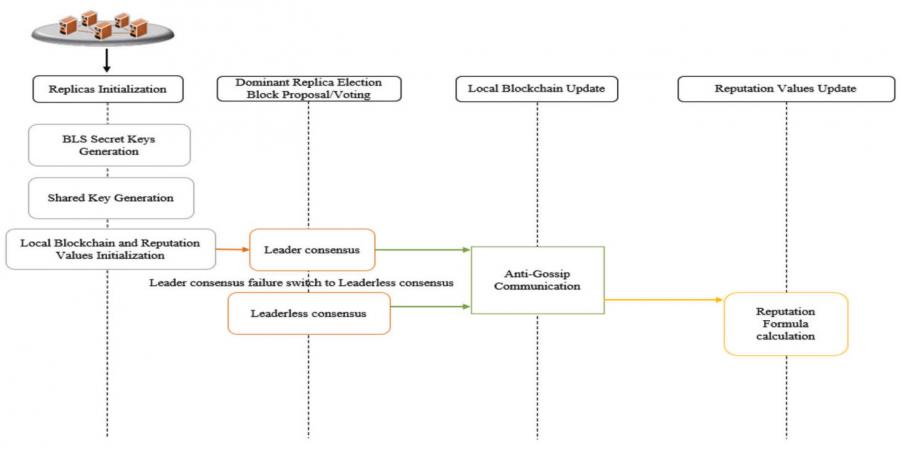
ATBFT merges the best of leader and leaderless consensus
GA, UNITED STATES, July 10, 2025 /EINPresswire.com/ -- Blockchain systems have long struggled to balance efficiency and reliability. Leader-based consensus mechanisms risk failure when a leader node crashes, while leaderless models often suffer from sluggish communication and instability. A new protocol—ATBFT (Adaptive Two-mode Byzantine Fault Tolerance)—promises to change the game. By dynamically switching between leader and leaderless modes based on real-time network conditions, and by using a reputation-based voting mechanism, ATBFT keeps transactions flowing without interruption. Its clever use of block decomposition and anti-gossip communication further boosts performance. Lab simulations show that ATBFT outperforms existing systems, delivering a 25% efficiency gain and a 20% increase in throughput.
As blockchain technology matures and expands into applications like digital finance, supply chains, and healthcare data, the limitations of existing consensus algorithms are becoming increasingly evident. Leader-based Byzantine Fault Tolerance (BFT) protocols can stall when their designated leader node fails, while leaderless models introduce randomness that slows down consensus and increases communication costs. Attempts to enhance each model individually have yet to resolve these fundamental trade-offs. Due to these persistent performance and stability gaps, there is a growing need for a hybrid solution that leverages the strengths of both systems to support fast, secure, and uninterrupted blockchain operations. Addressing these issues requires a new consensus design paradigm.
A research team from Shandong University and Newcastle University has developed a next-generation blockchain protocol called ATBFT, recently published (DOI: 10.1016/j.bcra.2024.100255) in Blockchain: Research and Applications (January 2, 2025). This adaptive protocol intelligently toggles between leader-based and leaderless consensus modes, guided by a reputation scoring mechanism. The result is a system that ensures smoother block generation, faster execution, and uninterrupted transactions—even when network faults occur. Through rigorous testing, ATBFT (Adaptive Two-mode Byzantine Fault Tolerance) has shown remarkable improvements in both speed and reliability, positioning it as a promising solution for enterprise-grade blockchain deployments.
ATBFT tackles three persistent challenges in blockchain consensus: leader failure, transaction disruption, and communication overhead. It introduces a real-time switching mechanism that allows the system to alternate between leader-driven and decentralized consensus models, depending on network health. This seamless transition is governed by a reputation-based election process that prioritizes reliable nodes, dramatically reducing the risk of system paralysis. In a novel twist, the protocol also decouples blocks into lightweight headers and separately propagated bodies. Consensus is achieved via headers, while transaction data flows asynchronously using an “anti-gossip” communication model, easing bandwidth stress and accelerating agreement. A pipelined process ensures that block commitment and proposal run in parallel, keeping the system active at all times.
Simulation experiments involving up to 100 virtual nodes revealed that ATBFT not only maintains transaction continuity but also increases the rate of block production. Compared to leading consensus protocols like HotStuff and TSBFT, ATBFT demonstrated superior resilience and performance—making it a strong contender for high-throughput blockchain applications.
“ATBFT is a milestone in the evolution of blockchain consensus,” said Dr. Lanju Kong, corresponding author of the study. “Instead of choosing between performance and reliability, we've engineered a protocol that delivers both. The reputation system brings accountability, while the adaptive switching ensures continuous operation—even when failures occur. It's a robust framework designed with the realities of enterprise blockchain in mind.”
With its emphasis on speed, stability, and uninterrupted operation, ATBFT is poised to support critical applications in digital finance, logistics, healthcare, and government services—where transaction downtime is not an option. Its flexible architecture allows for integration into existing blockchain infrastructure, making it a practical upgrade path for systems struggling with the limitations of current protocols. As organizations increasingly demand performance without compromising on trust, ATBFT offers a forward-looking solution tailored to meet the needs of the next generation of decentralized platforms.
DOI
10.1016/j.bcra.2024.100255
Original Source URL
https://doi.org/10.1016/j.bcra.2024.100255
Funding information
This work was supported by the National Key Research and Development Program of China (2021YFB2700100) and the Major Science and Technology Innovation of Shandong Province (2021CXGC010108).
Lucy Wang
BioDesign Research
email us here
Distribution channels: Business & Economy
Legal Disclaimer:
EIN Presswire provides this news content "as is" without warranty of any kind. We do not accept any responsibility or liability for the accuracy, content, images, videos, licenses, completeness, legality, or reliability of the information contained in this article. If you have any complaints or copyright issues related to this article, kindly contact the author above.
Submit your press release
